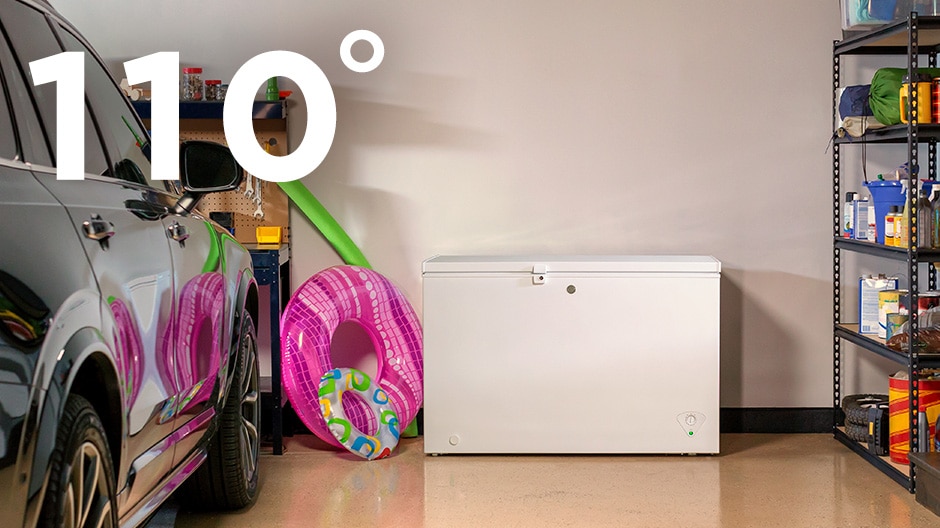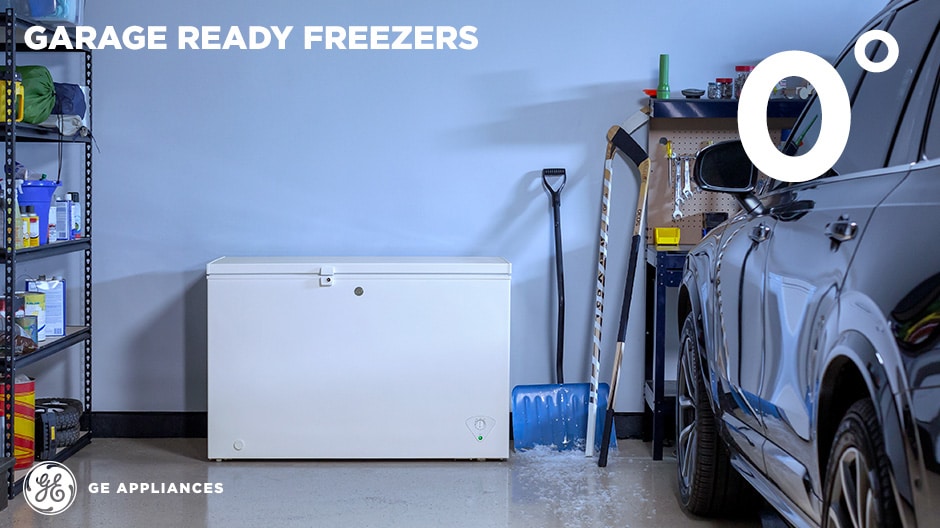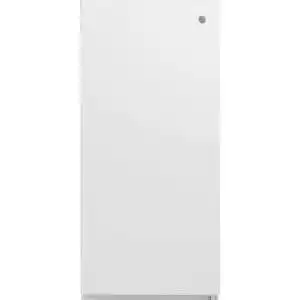While growing up in Pennsylvania, many of my neighbors had freezer chests in their garage. Many used it for bulk food storage, but some were hunters who stored venison for months after the season.
Either way, the garage had a lot of free space, and keeping a second freezer in garages seemed like a perfect solution.
We’ve already covered why many people wonder if you can keep a refrigerator in your garage, but what about a freezer?
Putting a freezer in the garage is okay if you are confident it won’t be exposed to extreme temperatures. Exposure to temperatures hotter than 110°F (43°C) and colder than 0°F (-17°C) may damage your freezer. The freezer will not work under these conditions, even in a properly insulated garage.
Freezers work by transferring heat inside the compartment to the outside. The process can be altered in the extreme temperatures typical in a garage.
Knowing how a freezer works is essential to understanding how a chest freezer can fit in your garage and how extreme temperatures could cause problems.
Frigidaire 14.8 Cu. Ft. Chest Freezer |
GE Garage Ready 14.1 cu. ft. Upright Freezer |
|
Primary Rating:
4.7
|
Primary Rating:
4.4
|
What is a Garage-Ready Freezer?
Most freezers and refrigerators are designed to work within a specific temperature range. Anything outside of that range and they might not work correctly.
You’ll usually find the lowest and highest operating temperatures labeled clearly on the unit itself. If not, another option is to go to the user manual or the manufacturer’s website to see your model’s recommended range.
Garage-ready refrigerators and freezers are designed to work on a broader temperature range.
If you haven’t purchased your garage freezer yet, look for “garage-ready” freezers that have climate ranges between 0°F (-17°C) and 110°F (43°C).
Once you know the freezer’s allowable temperature range, compare it to the average highs and lows for where you live.
I recommend adding and subtracting 15°F to the upper and lower boundaries. Temperatures will vary, sometimes considerably from those ranges.
Otherwise, you may only be able to use your freezer if you insulate your garage. That’s not as scary as it sounds. This article explains why you should insulate your garage door and walls.
Can You Keep a Freezer in an Unheated Garage During Winter?
It’s counter-intuitive, but freezing temperatures are actually bad for your freezer.
That’s because cold weather outside the freezer tricks your freezer into thinking that it’s already freezing inside the freezer.
When the outside temperature is below freezing, it causes the freezer’s thermostat to shut off more often than it should. Occasionally, it stops working completely.
When that happens, the food inside may start to thaw.
More importantly, cold weather can cause frost to build around the freezer’s insulation layer. As the freezing and thawing continues, the insulation inside the freezer will gradually get damaged.
Eventually, this causes your garage freezer to not hold temperature as well. The compressor will work harder to compensate for that, leading to higher energy bills.
Will a Freezer Work in a Hot Garage?
Extremely hot temperatures in your garage can be much worse on your freezer.
This makes sense.
The hotter the temperature outside, the more your garage freezer has to work to keep it below 0 degrees. As the compressor works harder, the cost of running the appliance increases.
Keeping your freezer in your garage can use up to 50% more electricity than usual. This depends significantly on where you live and how hot it gets. You can lower this if you have an insulated or air-conditioned garage. Newer garage freezers are more energy efficient, which will also help.
With this extra workload, you may find yourself replacing parts earlier than you’d expect.
Often, this happens in the summer, when you need your garage freezer the most. A failure here can lead to hundreds of dollars in spoiled food.
Garage Freezer: What Happens To Your Electricity Bill?
Freezers and refrigerators have seen a massive improvement in energy efficiency in the last few decades.
A new freezer will save you around $215 to $270 per year compared to an older freezer.
Older freezers use between 750 to 1000 kilowatt-hours (kWh) of energy annually. This works out at $97-130 per year, using the national electric rate of 13 cents per kWh.
A freezer has to battle higher humidity and temperatures in your garage that cause it to work much harder. Hotter temperatures mean the compressor on your freezer will have to work much harder.
According to EnergyStar.gov, for every 1°F (-17°C) change in the temperature in the garage, compared to the ambient weather in your home, your freezer’s energy consumption will increase by 2.25% to 2.5%.
At 90°F (32°C), the freezer uses up to 50% more energy than when the temperature is 70°F (21°C).
The bottom line is that older garage freezers are already less efficient than newer models. Using freezers (or fridges) in an uninsulated garage will increase your electricity bill even further.
That’s a great reason to consider insulating your garage.
Tips & Tricks For Using a Freezer in Garages
If you must put your freezer in a garage where the temperatures can go as high or low as the recommended upper and lower limits of 110°F (43°C) and 0°F (-17°C), here are a few things you need to do.
Monitor the Temperature
First, you need some way to monitor the temperature in your garage. It’s normal for the temperature in your garage to be up to 15 degrees different than the temperature outside.
Without some way to monitor the temperature in your garage, you’d never know how hard your freezer was working.
I have the AcuRite thermometer, which also keeps track of relative humidity. My garage carbon monoxide detector from FirstAlert also has a temperature readout.
If the temperature in your garage keeps going outside your freezer’s recommended range, it is time for you to consider ways to moderate the temperature.
Make Sure Your Freezer Can Handle Extreme Temperatures
As we discussed earlier, the temperature where you live significantly impacts how much electricity your freezer uses.
Most freezers will work in temperatures up to about 110°F (40°C). However, your manufacturer may have a different limit, so check your manual. Then, find the average summer temperature in your area.
You’re good to go if the historical maximum temperature doesn’t get hotter than your garage freezer’s threshold.
However, anything you can do to lower the ambient temperature in your garage will help your electricity bill.


Don’t Leave It Empty
Here’s something else that may seem counter-intuitive. You can actually help your freezer work better and be more efficient by keeping it fully stocked.
You don’t need to fill it with groceries, though.
A few gallons of water can fill the space and help the freezer maintain its temperature as the door is opened multiple times during the day.
When you open your freezer door, warm air rushes in from the outside, lowering the temperature. Then, the freezer has to work harder to cool it back down.
Keeping your garage freezer full leaves less room for the air to settle. Plus, the frozen items in the freezer help keep the temperature cold.
This ensures that the air inside can return to normal temperatures quickly when the door is closed.
Ensure It Has Enough Power
Your kitchen fridge and freezer typically have a dedicated circuit to power them. This typically includes a 115-volt, 60 Hz, AC-only electric outlet.
That’s not common in most garages unless it’s specifically installed.
If your garage doesn’t have a dedicated circuit with enough power for a garage freezer, have that installed first. You can find out the cost of installing another outlet in your garage here.
Without enough power, the freezer may trip a circuit, or the condenser inside may not work correctly. When that happens, it could lead to the quick burnout of essential components.
Insulate or Air Condition Your Garage
If, like me, the temperature in your garage is too high for a freezer, the next step is to either insulate or air condition your garage.
Possibly both.
I’ve discussed garage insulation earlier, and it can be a great inexpensive option. As long as you do it right.
It made a huge difference when I insulated my garage walls. Simply adding a garage door insulation kit lowered the temperatures in my garage by several degrees.
If insulating your garage still doesn’t bring the temperature down to where it needs to be, adding air conditioning is the next step.
However, air conditioning your entire garage can get expensive. Whole garage systems can cost several thousand dollars, and even portable air conditioning can cost several hundred dollars.
For more information on garage air conditioning, check out my in-depth guide, where I go over the pros and cons of each type of garage air conditioner. I also offer some recommendations, specifically for the garage.
Whether you insulate your garage or air condition it, you’ll want to keep as much warm air outside as possible. Keep your garage doors and windows closed at all times and seal up any leaks you may find.
Upgrade Your Old Freezer
If you have a freezer older than 2004, consider upgrading to a newer model. This will help save $50 a year, and you could choose a garage freezer with a better operating temperature range.
Unfortunately, nearly 15% of people have freezers over twenty years old. That means the freezer is nowhere near as energy efficient as newer models. Using an older freezer in a garage with temperature extremes will undoubtedly add to your electricity bill.
Use the Energy Star Flip Your Fridge Calculator to estimate how much you can save.
Finally, it’s important to check your warranty. Depending on the manufacturer, using your freezer in a garage could actually void your warranty.
Wrapping It Up
The garage is great for keeping a large freezer chest or second unit.
However, it’s essential to look at how extreme the temperatures get where you live and get a freezer that can work in them.
Remember that using a freezer in garages will likely use more electricity than you expect – sometimes up to 50% more!
It makes matters worse if you have an older, less energy-efficient freezer.
The key is to ensure that your garage won’t get too cold or too hot for the freezer at any point. Replacing your old freezer can save some money on electricity, but insulating your garage will have the most significant effect.



